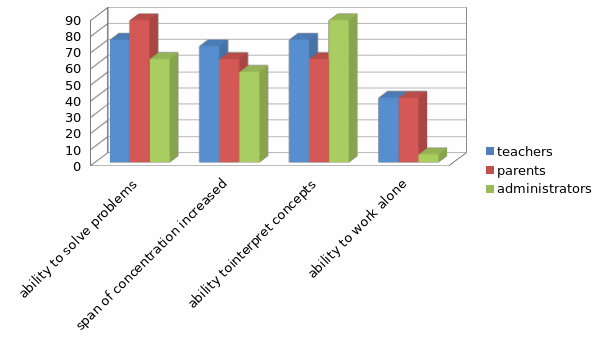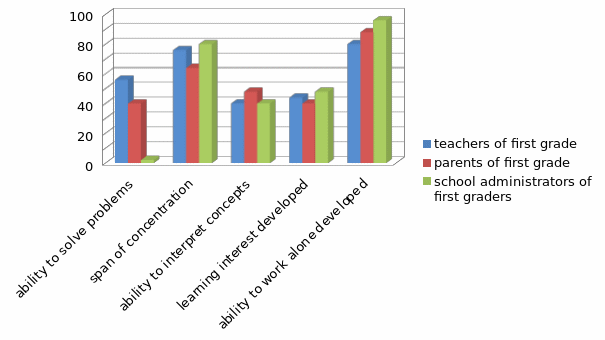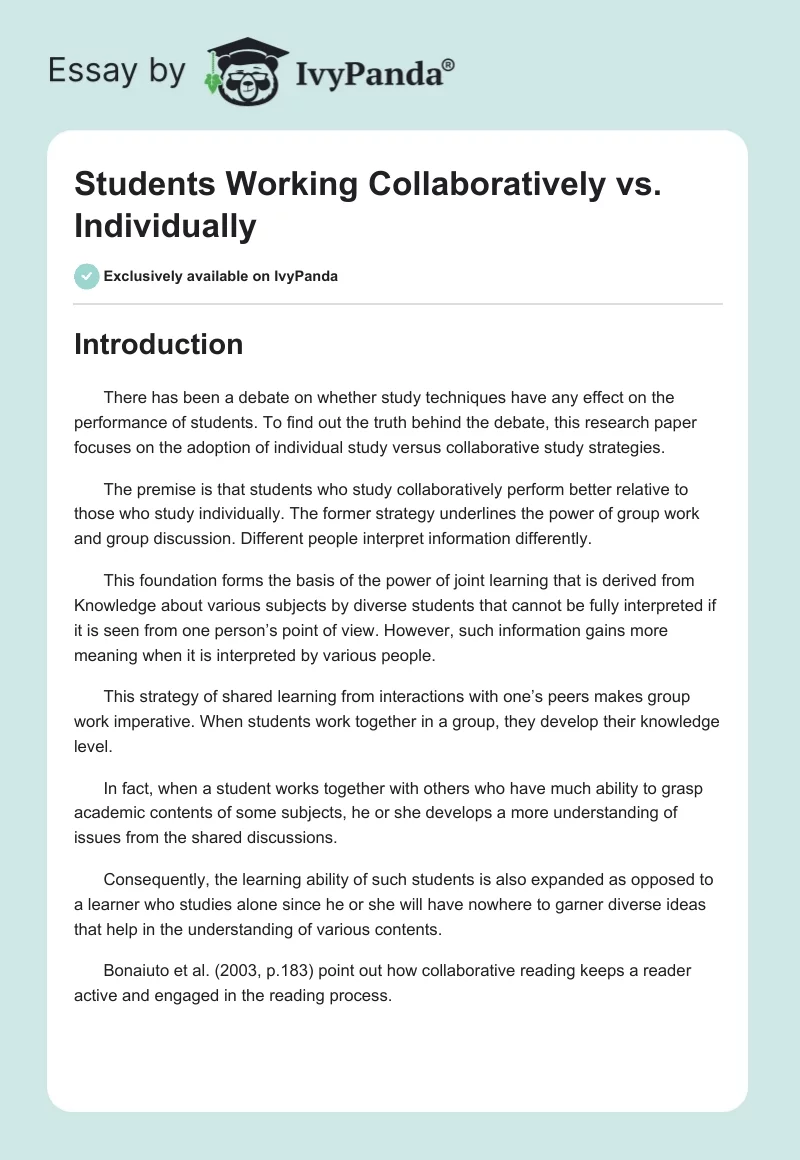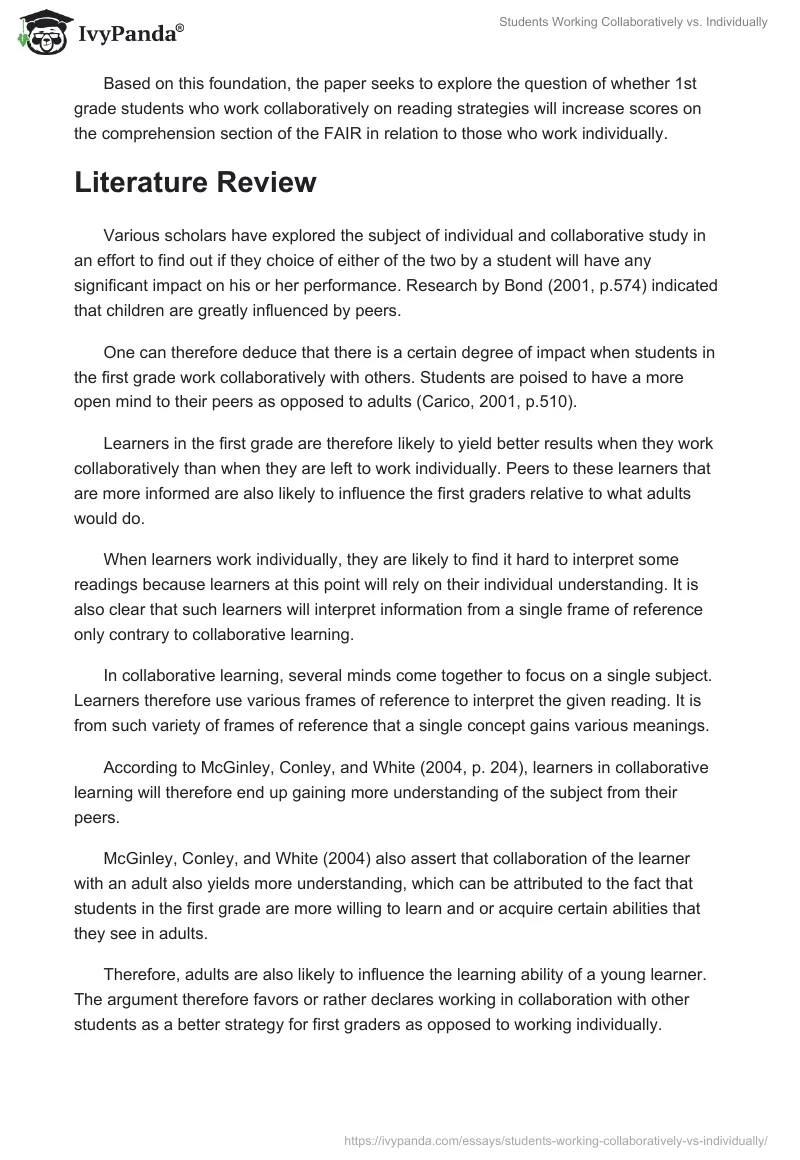Introduction
There has been a debate on whether study techniques have any effect on the performance of students. To find out the truth behind the debate, this research paper focuses on the adoption of individual study versus collaborative study strategies.
The premise is that students who study collaboratively perform better relative to those who study individually. The former strategy underlines the power of group work and group discussion. Different people interpret information differently.
This foundation forms the basis of the power of joint learning that is derived from Knowledge about various subjects by diverse students that cannot be fully interpreted if it is seen from one person’s point of view. However, such information gains more meaning when it is interpreted by various people.
This strategy of shared learning from interactions with one’s peers makes group work imperative. When students work together in a group, they develop their knowledge level.
In fact, when a student works together with others who have much ability to grasp academic contents of some subjects, he or she develops a more understanding of issues from the shared discussions.
Consequently, the learning ability of such students is also expanded as opposed to a learner who studies alone since he or she will have nowhere to garner diverse ideas that help in the understanding of various contents.
Bonaiuto et al. (2003, p.183) point out how collaborative reading keeps a reader active and engaged in the reading process.
Based on this foundation, the paper seeks to explore the question of whether 1st grade students who work collaboratively on reading strategies will increase scores on the comprehension section of the FAIR in relation to those who work individually.
Literature Review
Various scholars have explored the subject of individual and collaborative study in an effort to find out if they choice of either of the two by a student will have any significant impact on his or her performance. Research by Bond (2001, p.574) indicated that children are greatly influenced by peers.
One can therefore deduce that there is a certain degree of impact when students in the first grade work collaboratively with others. Students are poised to have a more open mind to their peers as opposed to adults (Carico, 2001, p.510).
Learners in the first grade are therefore likely to yield better results when they work collaboratively than when they are left to work individually. Peers to these learners that are more informed are also likely to influence the first graders relative to what adults would do.
When learners work individually, they are likely to find it hard to interpret some readings because learners at this point will rely on their individual understanding. It is also clear that such learners will interpret information from a single frame of reference only contrary to collaborative learning.
In collaborative learning, several minds come together to focus on a single subject. Learners therefore use various frames of reference to interpret the given reading. It is from such variety of frames of reference that a single concept gains various meanings.
According to McGinley, Conley, and White (2004, p. 204), learners in collaborative learning will therefore end up gaining more understanding of the subject from their peers.
McGinley, Conley, and White (2004) also assert that collaboration of the learner with an adult also yields more understanding, which can be attributed to the fact that students in the first grade are more willing to learn and or acquire certain abilities that they see in adults.
Therefore, adults are also likely to influence the learning ability of a young learner. The argument therefore favors or rather declares working in collaboration with other students as a better strategy for first graders as opposed to working individually.
Past researches by McGinley, Conley, and White (2004) also indicated that, when learners interact with mentors who are more exposed and experienced in diverse areas of academics, they are able to perform better in relation to their classmates.
It is therefore deducible that learners who work in collaboration with more experienced people will perform better than those learners who work individually.
Learners also gain diverse interpretation of information when they interact with more informed peers meaning that those who collaborate with experienced partners are exposed to different interpretations of certain information hence securing a chance to learn to reconsider other ideas before making a judgment (Mackie, 2009, p. 31).
From interaction with peers, students in the first grade will therefore acquire new knowledge with which they can use to interpret information more correctly. Those who have more information than others are also able to perform better in reading and writing hence standing a chance to perform better in various appraisals.
According to the findings of a research done by Coultas (2010), many benefits come from allowing students to interact with their partners in the process of learning.
Coultas (2010) realized that, when they work in collaboration, the meanings they attribute to certain readings are not based on individual interaction but from pooled understanding. When they are reading, they discuss how they understand various readings and finally come to an agreement.
This agreement eliminates the power of individual interpretations meaning that construction and social interaction gain prominence.
Students who work individually rely on individual understandings and interpretation (Heckert, 2004, p.43). This strategy is therefore seen as a weak interpretation of information. Hence, the performance of such a learner is low.
Fialho, Zyngier, and Miall (2011) found that, when students discuss amongst themselves, they become catalysts for the subjects of their discussion. Fialho, Zyngier, and Miall (2011) argue that the technique inspires young learners to develop personal interest for learning.
From such collaboration in learning, students will voice their previous knowledge about a certain subject with such an expression making other learners activated. They feel enthusiastic to remember and relate the idea with what others have said.
This strategy makes learning more interesting and comfortable for the first graders. Shared knowledge from experiences is seen as the foundation of discussion and understanding of various concepts (Carico, 2001, p.510).
Collaborative learning also makes first graders have the urge to ask clarification of subjects and ideas that they do not understand. In the course of interaction with the peers, they challenge information that comes from others and even from the reading materials.
They will always want to know how, why, when, and what concerning various subjects that they are exposed to in their discussions. Carico, (2001) is for the opinion that the questions, points of view, predictions, and arguments end up contributing to the meaning that is finally constructed in the real world.
To understand this concept of collaborative learning, one needs to realize that, in such an environment the implication that finally constructed began as an idea from one group member. It is from this idea that the others built on with a proper sense being finally developed.
When one member voices his or her opinions, she or he becomes a catalyst for others to remember and explore options and possibilities (Cameron et al., 2009, p.63).
Individual learning has been associated with increased spans of concentration. However, collaborative learning increases the spans of concentration since individual students take ownership of the topic of discussion. Students generate ideas concerning a certain topic, discuss it, explore various options and possibilities on their own, argue with peers on this subject, and finally conclude (Coultas, 2010, p.15).
Other researches by Maine and Waller (2011, p.354) revealed that collaborative learning offers the scholar with alternate roles in solving problems. First graders develop a different understanding of various items of discussion.
One of them may have incomplete or insufficient information about a certain item while his or her peer may have the whole information concerning the same (Maine & Waller, 2011).
The two parties can complement each other and end up realizing the correct information. This technique makes collaborative learning better than individual learning.
Refuting the notion that individual learning is more productive than collaborative learning McGinley, Conley, and White (2004, p. 204)) affirm that, what a child can do in cooperation today, he can do alone tomorrow.
According to McGinley, Conley, and White (2004), collaborative learning will therefore be more effective than individual learning.
Zhang, Stahl, Dougherty, and Katherine (2011, p.257) also found that collaborative learning offers a platform that brings together both social and cognitive learning. With the two, education becomes complete and wholesome. Such a student will therefore have the ability to appreciate other people’s ideas and opinions.
He or she will understand the importance of having a good relationship with others since they can help him or her solve problems in life. Various topics make students realize the potential in others. Hence, they appreciate the power of group discussion.
Students who work individually may develop an egocentric character since they rely on their own understanding (Mackie, 2009, p.30).
With such a notion, they may never appreciate the need to work with others in life. Individual working makes them believe that life is about themselves and not others. They will never appreciate the role of teamwork.
Methodology
This section will deal with research methodology to be employed in the process of conducting this research. The chapter will therefore include research design, sources of data, and tools for data analysis.
The research will adopt a descriptive survey design to investigate whether collaborative learning will yield better results than individual study. The research will cover students of the first grade.
The research design will entail data collection from a specific population of students who will be used to determine the position of that population concerning various variables. This design is informative since it describes variables like behavior, values, characteristics, and attitude of the students towards their studies.
Such a design will be the best for this study. It is also worth noting that this design studies the whole object or individuals as a unit and not in pieces or parts. This technique makes it go deep into studying and understanding the issue under scrutiny.
Descriptive survey is therefore the best for this research. The research will collect data from various learners in their first grade and their teachers from various schools in California in the United States. It will get its primary data from these sources.
The research setting to be adopted in this study will be first graders, teachers, school administrators, and parents of the first graders from various schools in the state of California, United States. The major reason for narrowing down to this sample is that the research revolves around them.
The strategy will therefore be the best for this research. It will adopt the use of questionnaires, which will include open and close-ended questions. The sample to be collected will include 50 teachers of the first graders, 25 school administrators, and 25 parents of the first graders.
Using stratified random sampling, 50 teachers in the first grade, 25 school administrators of first graders, and 25 parents of first graders will be selected. After collecting all the data, the researcher will proceed to code the collected data for purposes of analysis.
Descriptive and statistical procedures will be applied in analyzing this data. Percentages and means will be adopted as statistical analysis procedures for this research. Finally, the results will be presented in a summary form using bar graphs and frequency tables.
Anticipated results
Data presentation
Table 1.a Performance ratings in percentage of students of first grade who use collaborate learning for their studies
Bar graph 1.b. Performance ratings in percentage of students of first grade who use collaborative learning for their studies

Table 2.a Performance ratings in percentage of students of first grade who use individual learning for their studies
Bar graph 2.b. Performance ratings in percentage of students of first grade who use individual learning for their studies

Discussion of Findings
From the findings above, this section will discuss and analyze the information will to give a clear inference of whether indeed study techniques have any influence on students’ performance.
From table 1.0, the research shows that first graders who work in collaboration with others are likely to score the highest average in their ability to solve problems. This remark was indicated by an average of 76%.
Out of this figure, 76% teachers of first graders from various schools in the State of California indicated that first graders who use collaborative learning would have a high ability to manage tests.
Surprisingly, 88% of parents believed that having students working collaboratively would increase their ability to handle class content questions.
On the other side, findings from table 2.0 indicated almost contrary results. From this table, the research found that, when learners in the first grade study individually, their ability to handle class tests is not raised.
On average, only 8% of the total respondents thought that learners’ ability to solve problems is raised by learning individually.
From bar graph 2.b, the research indicated that 6% of teachers of the first graders, 4% of parent, and 8% of school administrators dealing with first graders believed that working alone would develop learners’ ability to solve problems.
The research can therefore deduce that, when learners in the first grade work in collaboration, their ability to solve problems is boosted.
The research also indicated that the concentration span of first graders varies with individual learning and collaborative learning. From table 1.0, the research indicated that an average of 64% of the total respondents believed that collaborative learning increases the concentration span of the learner.
Out of these, 72% were teachers, 64% were parents, and 64% were school administrators. This finding was way below the findings in individual learning. According to table 2.0, an average of 74% of the total respondents believed that, when students work individually, their concentration span increases.
From bar graph 2.b, the research indicates that parameter comprised 76% teachers, 64% parents, and 80% school administrators. The reader can therefore deduce from the findings that, when learners work individually, their span of concentration increases compared to first grade students who work in collaboration.
This case can be attributed to the fact that, when first graders work in groups, they keep on interrupting each other. It can also be linked with the tendency to continue with the conversation even after they reach a conclusion on what they were discussing.
In most instances, students’ minds will be swayed far and beyond the classroom by various opinions that are voiced by other members of the discussion. It will therefore take time to bring their minds back to class even after the discussion is over.
In most instances, uncontrolled group discussion ends up as noise making groups in class. The temptation to discuss other matters apart from the actual academic subject is also very high. The argument reveals why group discussion may require too much attention of the parent, teacher, or administrator.
Another variable that this research investigated is the ability to interpret information. From table 1.0, the reader can interpret that an average of 76% of the total respondents believed that, when students work in collaboration, they develop high ability to interpret information.
Out of the given figures, 76% were teachers of the first graders, 64% were parents, and 88% were administrators of first graders. This finding indicates that, when students in the first grade are allowed to work in groups, they develop high ability to construe the information.
This finding was far much higher than what was indicated by table 2.0. From table 2.0, one can deduce that only an average of 43% of the total respondents believed that the capacity to understand information by students in the first grade would be increased when they study on an individual basis.
From the subsequent bar graph 2.b, the reader will deduce that, out of an average of 43%, only 40% of teachers, 48% of parents, and 40% of administrators believed that working individually would increase first graders’ ability to construe the information.
Therefore, when first graders work in groups, their ability to take information is raised. This parameter had a higher score on average relative to when students work individually. From this information, one can argue that, since students share information when discussing, a meeting of ideas is formed.
Every one of them has a certain frame of reference. The research also indicated that the ability to work alone is different in different modes of study.
For example, from table 1.0, one will realize that an average of 40% of the total respondents believed that, when students in the first grade work in collaboration, their ability to work alone is nurtured. This inference had a low percentage.
From the bar graph 1.a, out of an average of 40%, a portion of it (40%) comprised teachers who taught the first graders, the other 40% was composed of the parents to the first graders, and the remaining 40% comprised the administrators who were concerned with first graders at school.
This finding indicates that there were some similarities in the results. Such similarities in research act as a confirmation of accuracy of the idea. Therefore, one can argue that students who always work in collaboration may face difficulties in working alone.
To confirm this argument even further, Table 2.0 indicated otherwise. From this table, one realizes that, when learners in the first grade are left to work individually, they have a higher ability of working alone. This remark took an average of 88% of the total respondents that participated in the research.
Out of this average, 80% were teachers of the first graders, 88% were parents of the first graders, and 96% were administrators that were involved with the first graders.
This finding indicates that a very high percentage of the Californians believed that individual learning would assist a learner to develop skills to work alone. The results could be attributed to the fact that, when students in the first grade get used to always working with others, they develop a dependency syndrome.
Out of such enslavement, students may never learn how to do their own private studies (Barton & Greenwood, 2009, p.57). They may not even appreciate the need for having personal goals and aspirations.
Whenever they face an academic problem, they will tend to look for help from others hence forming a belief that the solution to most of the problems lies on their partners. This notion reveals why the bar graph 1.b and 2.b differ largely.
One can therefore interpret that, for learners in the first grade to develop a sense of working alone, their parents, teachers, and school administrators must cultivate the skills of individual studies. This strategy will make the learners believe in themselves and become more independent in handling tasks.
Conclusion
In conclusion, it is clear from the above study that students who work in collaboration are likely to yield better results than their counterparts who study individually.
Researches have indicated that a very high percentage of the respondents from the sample population were for the idea that collaborative learning yields better results as opposed to individual studies. One can therefore conclude that learners in the first grade should be allowed to learn in collaboration.
Collaborative learning enables them to appreciate working with others, motivates them to want to study more, acts as a catalyst to learning, and makes them gain more ability to solve problems.
This research also indicated that individual learning enhances the ability for the first graders to work alone hence failing to grasp the role of teamwork. The entire strategy works to their disadvantage. Hence, it should be discouraged for these students.
Reference List
Barton, E., & Greenwood, D. (2009). Findings. English Drama Media, 1(14), 57-58.
Bonaiuto, M., Castellana, E., & Pierro, A. (2003). Humor. International Journal of Humor Research, 16(2), 183.
Bond, F. (2001). Giving them free rein. Reading Teacher, 54(6), 574.
Cameron, L., Maslen, R., Todd, Z., Maule, J., Stratton, P., & Stanley, N. (2009). The Discourse Dynamics Approach to Metaphor and Metaphor-Led Discourse Analysis. Metaphor & Symbol, 24(2), 63-89.
Carico, M. (2001). Negotiating meaning in classroom literature discussions. Journal of Adolescent & Adult Literacy, 44(6), 510.
Coultas, V. (2010). A Revival of Talk: The Challenge for Oracy in Schools Now. English Drama Media, 1(16), 15-18.
Fialho, O., Zyngier, S., & Miall, D., (2011). Astroturfing Infotopia. English in Education, 45(3), 236-253.
Heckert, C. (2004). 8 Reasons I LOVE my writers group. Writer, 117(11), 43.
Mackie, G. (2009). Theoria: Astroturfing Infotopia. A Journal of Social & Political Theory, 56(119), 30-56.
Maine, F., & Waller, A. (2011). Swallows and Amazons Forever. Children’s Literature in Education, 42(4), 354-371.
McGinley, W., Conley, K., & White, W. (2000). Pedagogy for a few. Journal of Adolescent & Adult Literacy, 44(3), 204.
Zhang, J., Stahl, A., Dougherty, S., & Katherine, A., (2011). Collaborative Reasoning. Reading Teacher, 65(4), 257-260.


